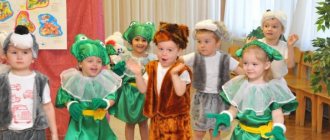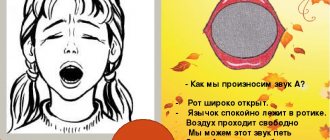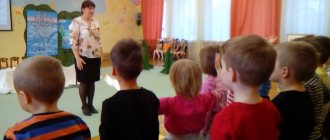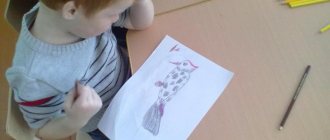The role of theatrical activities
Due to the fact that theatrical activities are based on play, it is easy for a preschooler to understand the tasks that are assigned to him. He can easily create the image of his character, give him character and live his life with him. The child develops imagination and thinks more broadly.
theatrical performance
Attention! Participation in theatrical productions allows one to identify a creative personality at a very early age, thanks to which parents can develop the child in a direction that is interesting to him, which can become the basis for successful self-realization in adulthood.
With the help of theatrical performances, children activate their vocabulary, improve the change in intonation while pronouncing lines, and practice constructing dialogues.
Introducing preschoolers to the theater
Theatrical activities in the senior group open the world of art to the kids. The teacher first introduces the concept of theater and the rules of behavior in it. The children are told about different types of theater:
- classic;
- pantomime;
- puppet;
- musical;
- finger
After which the teacher begins exercises on the strength of sound - reads quatrains at different volume levels, reinforcing what is said with gestures. During the familiarization process, children learn discipline and train to listen carefully to the speaker.
Attention! If you present your child with information about the theater as something magical and interesting, a positive association with art will be fixed in his mind, thanks to which he will be happy to independently increase his level of cultural development in adulthood.
Mitten Theater
Types of theatrical activities
Theatrical games in the senior group can be divided into two main types: dramatic and directorial. Children begin to master the second on their own when they play with toys: they control plush performers, speak for them, move them, and build relationships between toys.
The dramatic type of activity involves the child’s independent performance as an artist using various techniques of expressive speech.
Children as artists
Open classes
Open lessons on theatrical activities attract children with their naturalness. In the improvised auditorium sit not only familiar children and teachers, but also invited guests - parents and other teachers. The purpose of such a lesson is to demonstrate children’s involvement in art, the children’s ability to clearly and distinctly pronounce lines, and not be embarrassed by the audience.
Most often, such classes use costumes created by children together with their parents. Each child who takes part in the formation of his image becomes more closely connected with his character and is sensitive to his fate.
Didactic games using the Montessori method for children
Attention! Sometimes it is enough to let a preschooler decorate the mask of his hero so that he feels responsible for the fate of the character.
In some preschool institutions, during music classes, children are given cards with images of characters. Having each received their role, the guys play “Turnip”, “Kolobok” or “Teremok” to the accompaniment.
Drama games
Dramatizations allow preschool children to reveal their directing abilities. One student can control several characters at once, and children are often so carried away that they involuntarily adjust the intonation of their voice individually for each character. During such performances, children learn the significance of emotions and practice their facial and intonation demonstration. The definition of character is fixed - all the heroes in the fairy tale are different, each with their own temperamental characteristics.
It is not uncommon for teachers to put on several theatrical performances each season, reinforcing the study of nature and weather patterns through play. For example, in winter, children are invited to dramatize the process of preparing various animals for wintering: some fill bins with food, insulate their homes; others gorge themselves and hibernate, while others go to warmer climes.
Toy range for director's play
Self-analysis in planning theater activities
Experienced teachers, before drawing up an art teaching project for a year or a season, conduct a survey of parents, from which they learn about the degree of emotional liberation of the children, the clarity of the child’s speech at home, the ability to use facial expressions and gestures during communication and the inclinations to empathy .
After conducting the survey, the teacher becomes clear which aspects should be paid more attention to and which ones less when compiling a card index of theatrical games in the group.
Important! Self-analysis reveals the main directions in which the selected material should be worked on and identifies weaknesses in the emotional development of children.
DIY glove puppet
In reality, there are a lot of puppet theaters that can be built. Even at almost no cost. You just need to use your wits and do it! You can sew it, for example.
Or you can learn to knit and knit these cute little characters:
Honestly, I used to knit well, but now I don’t have enough time for it all. But I never liked sewing. But, as an option, you can also create a theater for those who love this business.
Although here is the simplest master for you - a class on sewing a puppet theater from fabric using gloves. Anyone can do it, even those who do not know the art of sewing.
We will need:
- household gloves, knitted - 2 pcs., buttons for the eyes - 2 pcs., thread, scissors, braid, stationery knife
Stages of work:
1. Take the first glove and steam the seam thread on the cuff, it is usually red or yellow. Tuck the little finger, thumb and index finger in so that they do not come out, sew them up. You should end up with a head with ears and a hare neck. Sew the bases of the ears to prevent your fingers from getting in there.
2. Now take the next glove and hide your ring finger in it, sew up the hole. Place your middle and index fingers together and now place the hare's head on them.
3. Sew the head to the neck. To hide the seam on your neck, tie it with a bow or tie in the shape of a butterfly. Sew button eyes and embroider a muzzle, or you can draw it with a marker. You can decorate a bunny using fluff or knitted threads by gluing a cute forelock to his head.
Theater project in the senior group
Play theater should be a constant presence in children's lives. To do this, teachers keep notes on theater activities, where they distribute various types of performances, evenly distributed throughout the academic year.
The results of the lessons in the garden are:
- communicative development of children of different ages;
- familiarization with the history of the origin of the theater and its purpose;
- joint creation of props and stage images;
- increasing parents' attention to the creative activities of preschoolers;
- creating a screen for further use by children in independent theatrical performances.
Making your own actors
The theater design should reflect the needs of children's development in accordance with their age characteristics. Often, children need to give free rein to their imagination to organize their own theatrical performance. So, children 4-5 years old can quite successfully put on a show using only spoons. A healthy imagination is enough to mentally endow each spoon with appearance, character, and create a fictional image. Even at the stage of self-analysis, teachers find out the pupils’ ability to think outside the box, leaving the child, as if by accident, alone at the table with two or three spoons. Some children begin to get bored over time and look in the direction of their frolicking peers, while others, already in the first minute, take up spoons and begin to play with them like dolls.
Scenarios for preschool propaganda teams on traffic rules in kindergarten
Additional Information! Children who are unable to create instruments for play from everyday objects using their imagination especially need theater, which will allow them to develop non-standard thinking and relieve them of emotional constraint.
Secrets of successful theater productions
How to make a paper theater more durable? After all, paper parts often tear and become unusable. And, most likely, this will happen after the first production of your play. Here is another option for making a theater at home, which, although more time-consuming, will last longer.
The first stage of production remains unchanged - we find templates (you can even draw them yourself if there are no ready-made ones). We print them on a color printer. Then we cut out the largest decorations, glue them to cardboard and additionally seal them with tape - this will add strength to them, and they will not get dirty.
Then we start making fairy tale heroes. At this stage we will need additional materials, namely:
- Small plastic jars for yoghurts like Rastishka or Agusha.
- Wooden ice cream sticks (if you don’t have them, plastic forks or spoons will also work).
- Stationery knife.
We cut out the characters and glue them onto a cardboard base. If your paper is quite thick, then you don’t have to do this. But most often, thicker paper is not “grabbed” by the printer for printing. Keep this in mind and try using different paper weights in your printer.
Be sure to tape it with tape to prevent the parts from fraying. Then we take ice cream sticks or plastic spoons and tape them with tape to the back of the paper blank so that the stick is “behind” the hero and has a free part at the bottom (3-4 cm). Using a utility knife, we make two cuts on the bottom of the yogurt jar - you should get a cross - and then simply insert the stick with the doll into this hole. All is ready! You can start playing!
As you can see, a home theater is a great way to diversify a child’s leisure time without much expense, because printing and cutting out the templates is not at all difficult. In addition, this is a good option for spending time together, which children always like, and also strengthens family relationships.








